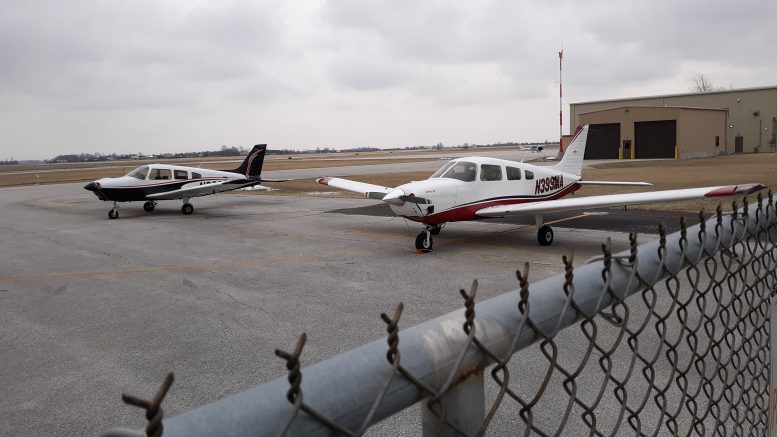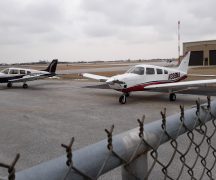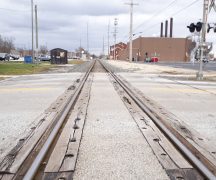By JAN LARSON McLAUGHLIN
BG Independent News
Wood County Regional Airport runway markings are fading and difficult for pilots to see as they approach the landing strip. And insufficient taxiways are leading to waits up to an hour long for pilots trying to take off.
Fixing those issues will take money – and the airport board said it’s losing out on federal funds because there are no local share funds in place when federal grants become available.
So on Thursday, members of the airport board presented funding requests to the Wood County Commissioners.
“At the end of the day, we’ve exhausted every effort” to get funding, airport board member Mike Liebenthal said.
Following are the funding requests presented to the commissioners on Thursday:
- Immediate request for $68,000 for repainting the runway markings.
- Near-term request, in the next three months, for $163,000 to engineer plans for airport improvement projects. These plans are to support the local share of funding in order to get federal grants in 2020.
- Long-term request of an annual allocation of $120,000 to go into a separate account for airport improvements, and to help access short-term loans to leverage federal funding when it becomes available.
The most critical need right now is the runway visibility.
“You really can’t see the pavement markers,” Liebenthal said of the fading runway paint. “We can’t identify the runway, and that’s a problem.”
The county commissioners approved the immediate request for $68,000.
The airport also needs to add turnarounds and taxiways for planes, according to the board members.
“We have traffic backups,” with planes waiting an hour to takeoff during heavy times, Liebenthal said.
And the airport lacks any sustainable budget for improvements.
“There is no fat on the bone,” Liebenthal said of the airports budget that is only able to keep up with maintenance.
So an increased annual allocation from the county would be set aside in a capital improvement budget. “So we’re ready to go when money is available,” Liebenthal said.
The airport board has sought funding from the FAA for improvements to the facility. The federal agency is willing to pay for 90 percent of project costs in some cases. But the airport has repeatedly lost out on consideration for those grants when the FAA asks about the local share for the projects, Liebenthal said.
The actual money isn’t needed ahead of projects – but a commitment from local officials that the funding will be forthcoming is necessary, he said.
Funding from the FAA is also more likely if the airport has “shovel-ready plans,” explained airport board member Jeff Hamons. But to do that, funding is needed for engineering.
“They want to know we have local sponsorship,” Hamons said of the FAA.
The revived BGSU aviation program at the Wood County Regional Airport has led to busier runways, hangar rentals and fuel sales. The program has 20 aircraft and is close to its 400 student limit, Hamons said.
“It’s quite a busy place,” he said.
The national pilot shortage – caused by fewer pilots retiring from military service and going into commercial flying – has created an increased demand for the BGSU program.
North Star Aviation, the private firm that provides flight training for BGSU students, is planning on doubling the size of the learning center at the airport. North Star is also working on plans for an additional hangar at the airport. So the airport authority will lose the rental from those planes moved to the new hangar. However, there are other private pilots in the area who are on a “waiting list” for the current hangar, Hamons said.
The airport authority gets an annual amount of $26,345 from the Wood County Commissioners and the same amount from the City of Bowling Green. It also gets about $40,000 a year for hangar rentals, another estimated $75,000 from fuel sales, and a small amount in farmland rental. But that income is needed to keep up with regular maintenance – not enough to fund capital improvement projects.




